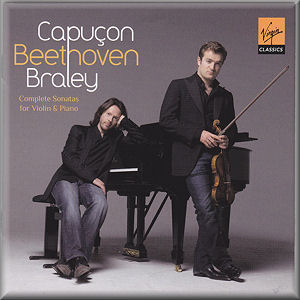 |
 |
|


alternatively
CD:
MDT
AmazonUK
AmazonUS
|
Ludwig van BEETHOVEN (1770-1827)
Violin Sonata No.1 in D, Op.12 No.1 (1797-98) [20:19]
Violin Sonata No.2 in A, Op.12 No.2 (1797-98) [16:15]
Violin Sonata No.3 in E flat, Op.12 No.3 (1797-98) [18:21]
Violin Sonata No.4 in A minor, Op.23 (1800) [16:12]
Violin Sonata No.5 in F, Op.24 'Spring' (1800-01) [23:21]
Violin Sonata No.8 in G, Op.30 No.3 (1801-02) [17:08]
Violin Sonata No.9 in A, Op.47 'Kreutzer' (1802-03) [36:47]
Violin Sonata No.6 in A, Op.30 No.1 (1801-02) [20:51]
Violin Sonata No.7 in C minor, Op.30 No.2 (1801-02) [24:16]
Violin Sonata No.10 in G, Op.96 (1812) [27:05]
 Renaud Capuçon (violin); Frank Braley (piano)
Renaud Capuçon (violin); Frank Braley (piano)
rec. September and October 2009, L’heure bleue, Salle de musique, La-Chaux-de-Fonds, Switzerland
 VIRGIN CLASSICS 6420010 [3 CDs: 71:44 + 77:45 + 73:47]
VIRGIN CLASSICS 6420010 [3 CDs: 71:44 + 77:45 + 73:47] 
|
|
|
Why add another set of the complete violin sonatas to your shelves?
If you’re historically minded you have the Kreisler/Rupp and
Heifetz/Emanuel Bay/Brooks Smith on your shelves. Possibly you’ve
dallied with Oistrakh/Oborin, or Schneiderhan/Kempff or Menuhin
and his pianistic partners. If you’re from the late LP era you
have the Perlman/Ashkenazy. If you’re a silver disc fanatic
you’ll certainly have acquired one of the more recent cycles;
it’s possible you even bought the recent Dumay/Pires set on
DG, and good for you if you did; it’s excellent. So what makes
this new cycle so special, and should you be interested?
Firstly, it’s been beautifully recorded, and the balance is
just right between the instruments. Second, the performances
are wonderfully lyrical and full of deft, imaginative and refined
gestures. The Spring Sonata is a most obvious place to start.
Gentle sensitivity is the way in which Capuçon and Braley play
it; bowing is quite light, articulation lacks much of the tensile
muscularity that other pairings bring to the music. The ethos
is a true give and take ensemble, whilst timbral contrasts are
genuinely refined. They characterise all three of the Eighth
sonata’s movements with real acumen, charting its moods and
paragraphs dextrously. There is nothing straight-laced about
the playing, and it’s not too rhythmically strict either. The
finale is notably vibrant and successful.
As for the Kreutzer, we find a consonant sense of the work’s
architecture and quixotic changeability. The opening movement
has plenty of propulsion but is neither over-vibrated by the
fiddle nor over-parted by the pianist. These are listening,
thoughtful performances indeed. A corollary is that certain
moments may be thought to be underplayed – take the opening
statements of the Kreutzer for example and also – despite the
fine sense of élan that comes with the unleashing of the first
variation in the central movement - certain moments subsequently.
This is a relative matter, of course, but I ought to note it.
They certainly do take a very relaxed view of the opening of
the Tenth sonata. It reinforces the intimacy they locate in
the works amidst the sense of dynamism. I happen to find this
movement rather devitalised, but acknowledge the consistency
of approach and can find nothing with which to argue in the
colouristic assurance of the same sonata’s finale. Similarly
there is a pleasurable articulacy in the opening of the Op.12
No.3 sonata – which is well balanced, naturally phrased and
not over-emoted. Braley proves a most able Beethovenian throughout
and an equal partner, and shows in the slow movement of this
E flat major sonata just how richly he can characterise.
So these are splendid, genuinely impressive performances. They’re
not stamped with the heroism of performers such as a number
of those cited above. They’re cut from a far more intimate cloth,
preferring incremental, dextrous playing. If your inclination
is for large scaled readings, then I suggest that these are
not for you. They exude a tenderness, and a relaxation, that
will appeal strongly to those who value chamber intimacies above
concertante vigour.
Jonathan Woolf
See also review by Michael
Cookson
|
|

